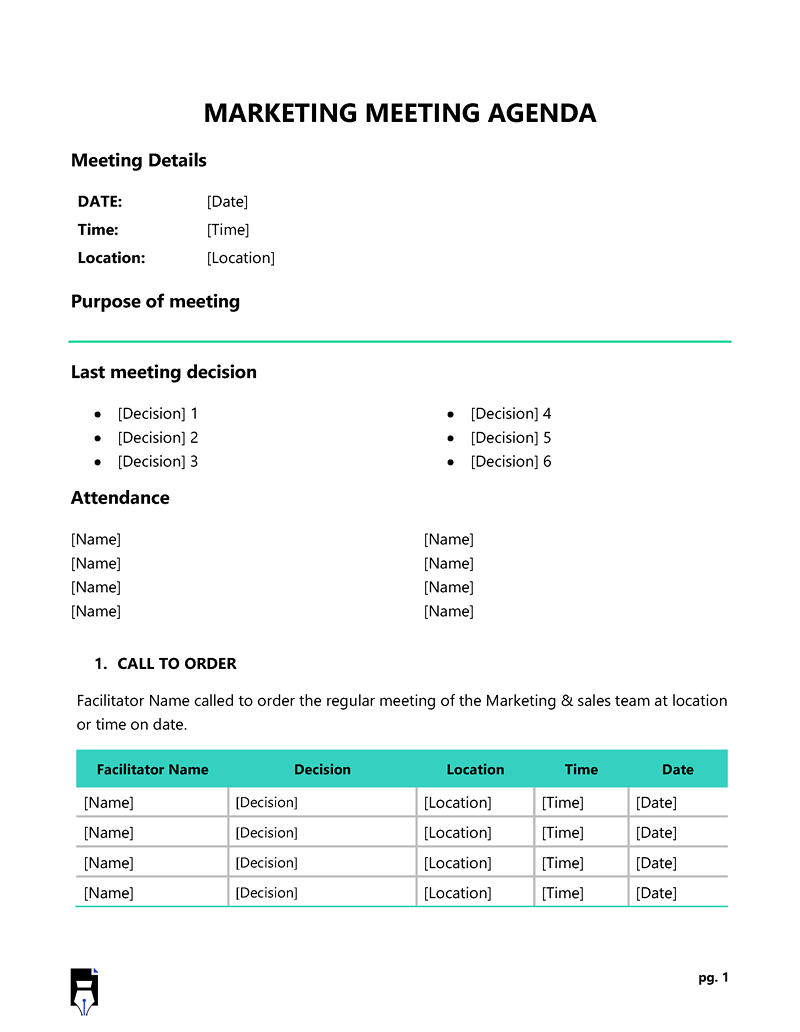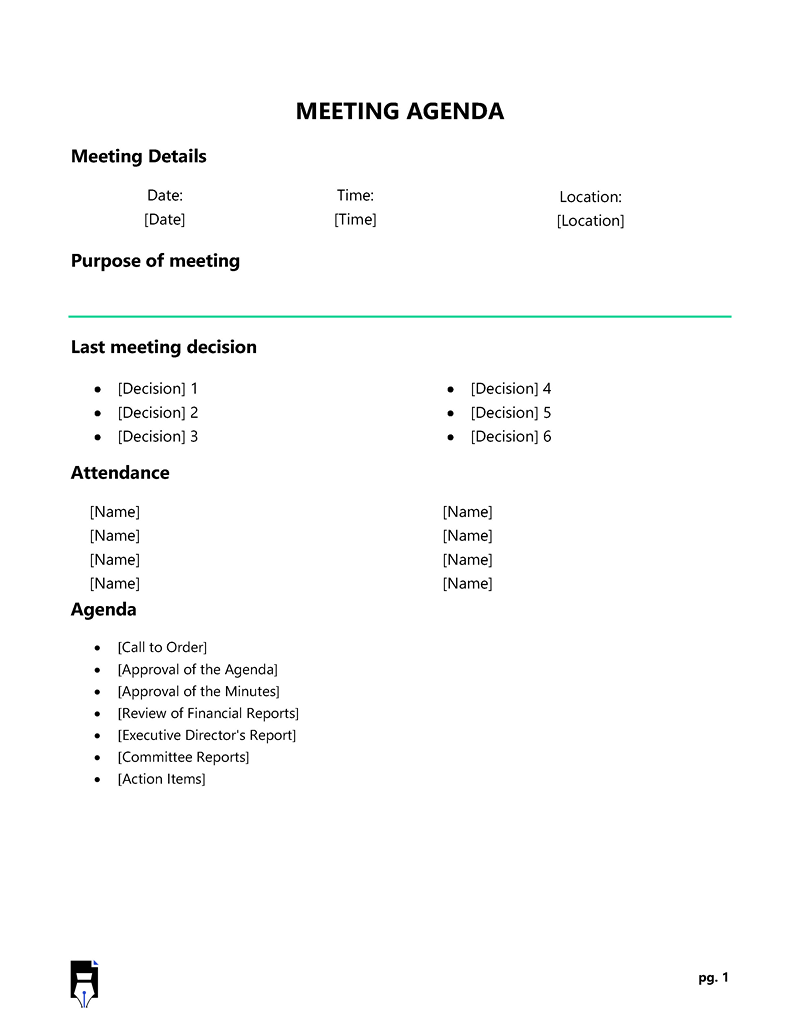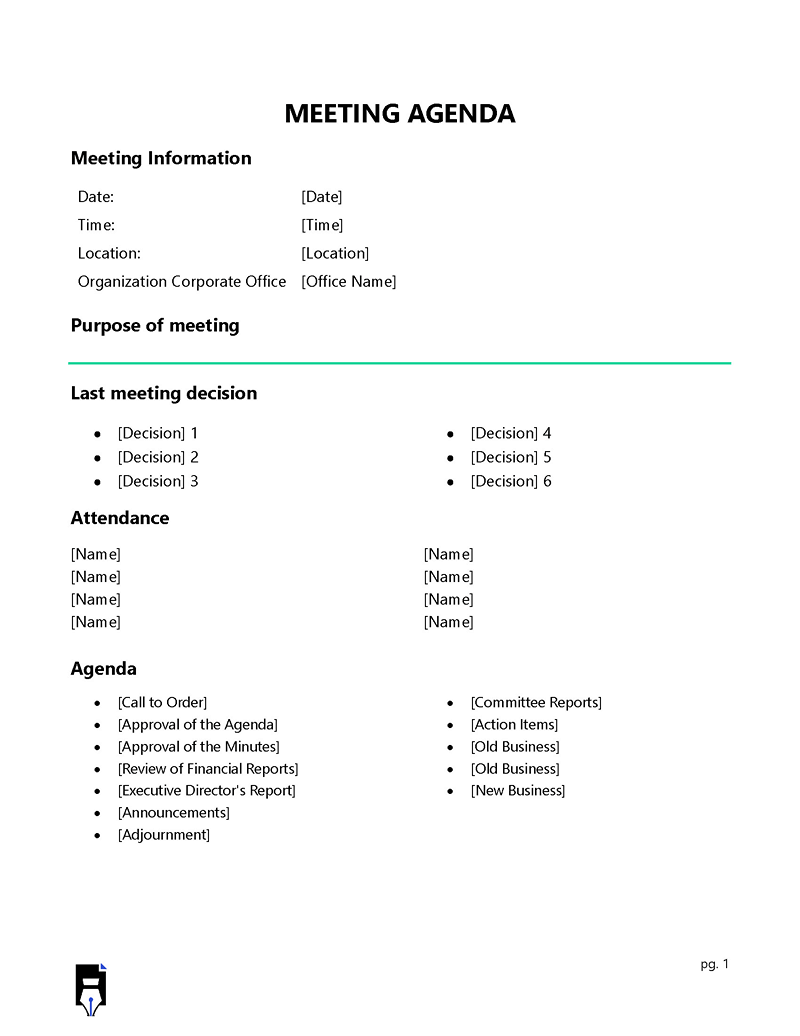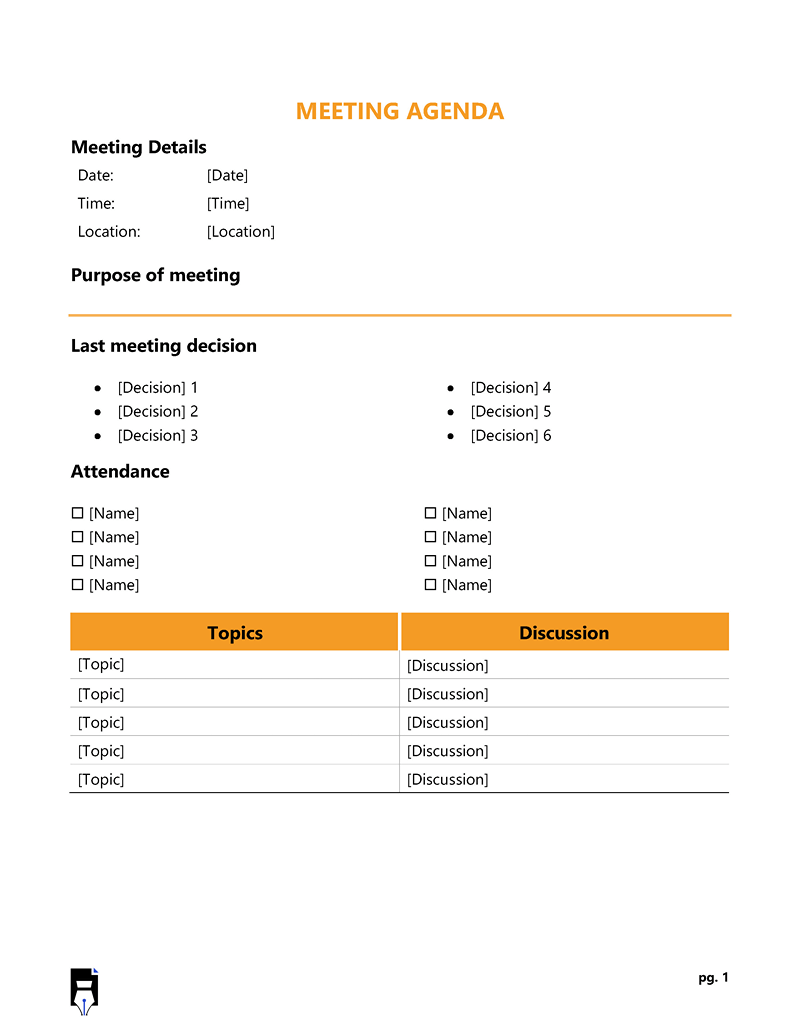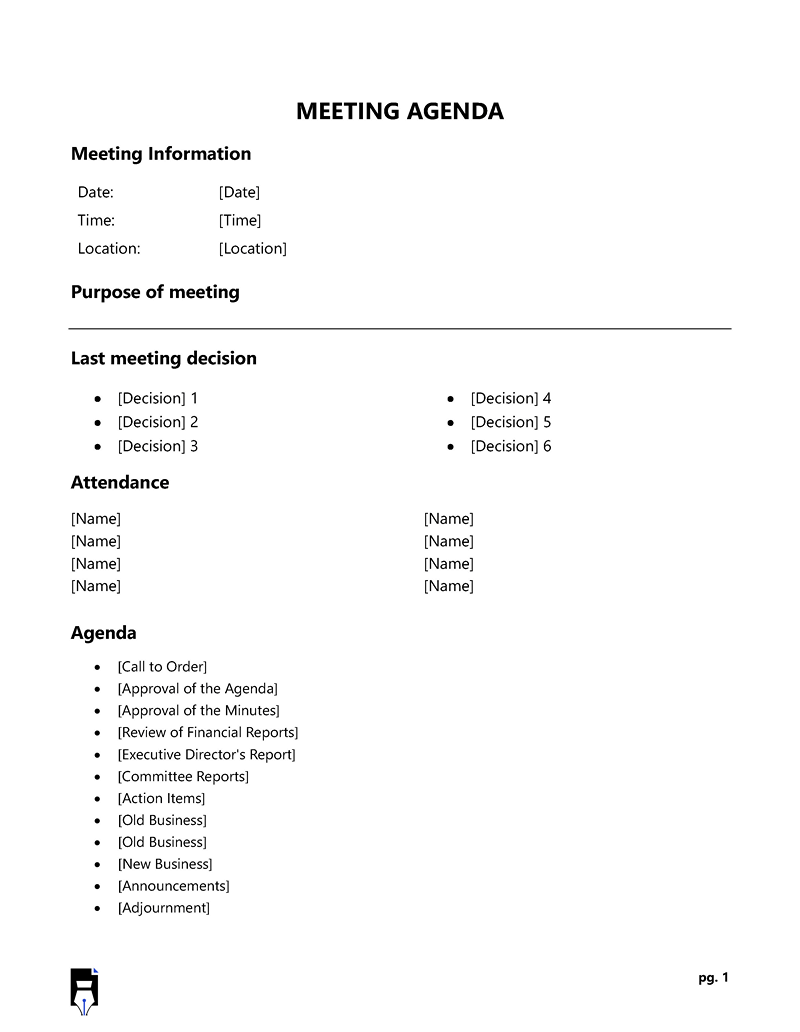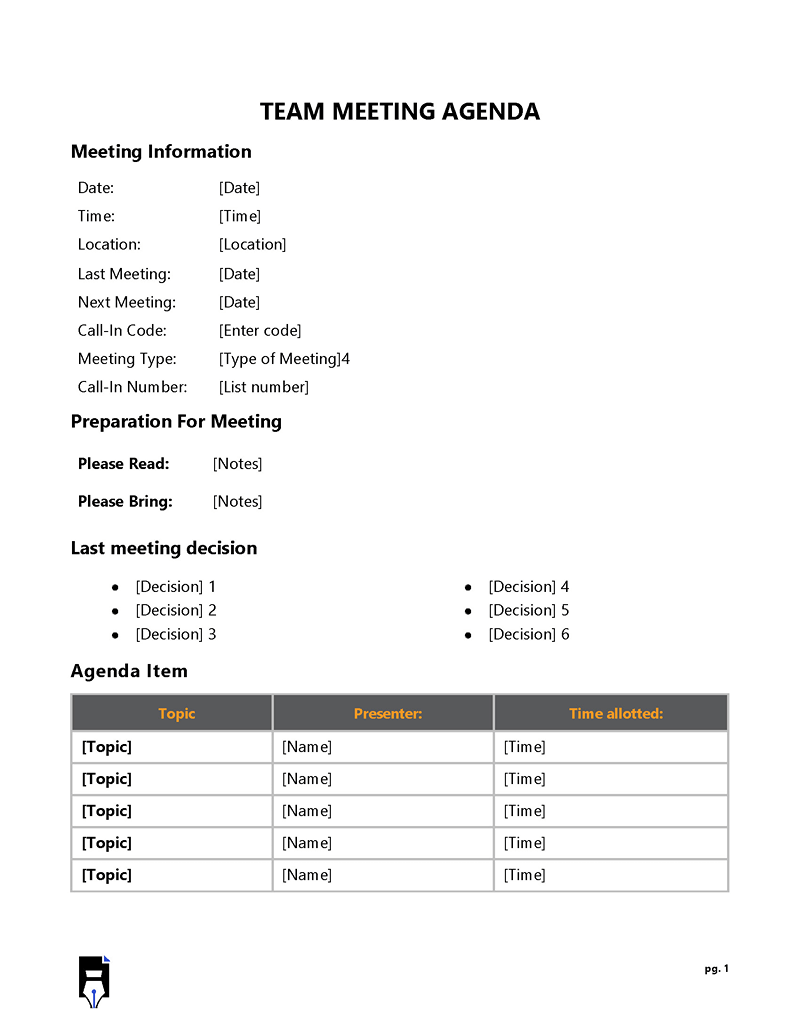A board meeting is a formal, scheduled meeting of the board of directors of an organization.
Members or shareholders of an organization appoint a director to represent their interests and make decisions on their behalf. Board meetings are typically held on a monthly, quarterly, or sometimes annual basis. These meetings are intended to provide a forum for the board to discuss and make decisions on important matters related to the organization.
These matters may include strategic planning, financial performance, management of risk, and other issues of concern to the organization. Board meetings may also be attended by other key stakeholders, such as the organization’s CEO, senior executives, and external advisors or consultants. Before the meeting takes place, a meeting agenda has to be set.
This article will guide you on a board meeting agenda, its structure, and how to take effective minutes for it. It also discusses certain practices to create it effectively.
Free Templates
Given below are meeting agenda templates:
What is a Board Meeting Agenda
An agenda is a list of items discussed and addressed during a board meeting. It serves as a roadmap for the discussion and helps participants understand the meeting’s purpose and focus. A typical board meeting agenda may include minutes, reports, and announcements, among other things. It needs to be well-organized and structured, as it helps to ensure that the meeting is productive and effective.
During the meeting, the chairperson allocates time for each topic. The agenda outlines these topics and allows the meeting to flow smoothly while members can contribute positively to each topic of the discussion. If the entire board can agree on the agenda topics, the organization can attain its vision.
Note: The task of taking minutes falls on the secretary. The chairperson or deputy chairperson has to lead the meeting; the treasurer has to oversee the funds, and the board members have to discuss certain aspects of the organization. Since every board member serves the organization in a specific capacity, the secretary has to take the minutes.
How to Take Effective Minutes for Board Meeting Agendas
Minute-taking is an important aspect of the agenda-making process as it documents the discussions, decisions, and actions that take place during board meetings. Minutes provide a written record of the proceedings, which can be referred to during subsequent board meetings. Additionally, minutes can be used to provide accountability and transparency, as they provide a clear and detailed account of who said what, who made which decisions, and which actions were agreed upon.
First and foremost, you should focus on the key points and decisions made during the meeting rather than recording every detail of the discussion. Moreover, use bullet points or short paragraphs to organize the information and make it easy to read. Use active voice and avoid complex jargon or technical terms that may not be familiar to all readers. An outline makes sure that any outstanding tasks are addressed and completed for members who were unable to attend the meeting. In some cases, the outline can serve as evidence in a legal proceeding.
Remember, you are taking minutes that may be read by someone in the next five or ten years. Therefore, you should record any action items or tasks the board will assign to specific individuals, including deadlines for completion. Then, review and revise the minutes after the meeting to ensure that they are accurate and complete. Finally, distribute the minutes to all attendees and relevant parties. By following these tips, you can take compelling and valuable minutes that accurately reflect the key decisions and discussions of the board meeting.
Anatomy of a Board Meeting Agenda
The elements included in a board meeting agenda will vary depending on the goals and needs of your organization. Therefore, you need to prioritize agenda items and allocate sufficient time for discussion to address all important matters.
Here are the items that you should include in your board meeting agenda:
Heading
The heading of a board meeting agenda serves as an introduction to the meeting. It contains the name of your organization. Moreover, you may include the date and time of the meeting and where it is held.
Call to order
This is the formal opening of your meeting, typically led by your chairperson or another designated board member. A call to order may be a prayer, greeting, or a highlight of the meeting’s objectives. Your secretary will note who made the call to order and at what time it was made.
The purpose of the call to order is to establish a quorum. A quorum is the minimum number of board members required for the meeting to be held. During the call to order, your chairperson may ask for a roll call to confirm the names of all board members who are present at the meeting.
Changes to the agenda
Your chairperson or another designated board member may present the proposed changes to the other board members for discussion and approval. Additions or omissions to or from the agenda are usually made at this point. These changes may be necessary to address unforeseen circumstances or to prioritize certain items that have emerged since the agenda was originally prepared. Your secretary will note down the proposed changes. If no changes are made, the agenda moves on to the next step.
Approval of previous minutes
Your chairperson presents the previous minutes to the other board members for review. The board members carefully review the minutes to ensure that the minutes are accurate and complete. In case of any errors or omissions, members can suggest changes or amendments to the minutes. Your secretary will note these changes in the current minutes. Once the board members are satisfied that the minutes are accurate and complete, a vote is held to approve the minutes. This vote typically requires a majority of board members present at the meeting.
Reports
Reports are an essential part of a board meeting, as they provide information and updates on the progress and status of various organizational initiatives and activities. You should evaluate the executive director’s report on the organization’s overall status, including any challenges or successes experienced. Committee chairs may present reports on the activities and progress of their committees, including any recommendations or decisions that need to be presented to the entire board.
A financial report on the organization’s financial performance, including a review of the budget, expenses, and revenues, may follow the committee reports. There may be other reports presented at your board meeting, depending on the needs and goals of your organization. This is usually one of the most manageable parts of a board meeting agenda.
Old business
Old business refers to items discussed in your previous meeting that still need to be completed or resolved. These items may include projects that are in progress, pending decisions, or issues yet to be addressed. Your secretary will note down updates on the status of the items, any new developments or issues that have arisen, and any decisions or actions that need to be taken.
New business
New business refers to items that are being presented or discussed for the first time in a board meeting. These items may include proposals for new projects or initiatives, updates on current projects, or any other matters that need to be addressed by your board. Your secretary should be keen to capture the essence of the discussion entirely.
Remarks, announcements, and other news
Remarks, announcements, updates, and news are typically made at the end of a board meeting that needs to be shared with your board. These remarks may include updates on the organization’s activities or projects, announcements about upcoming events or meetings, or other vital information the board should be aware of.
In some cases, board members may also make personal announcements or provide updates on their activities. Your secretary will note down announcements and remarks, as they help to ensure that your board is aware of essential developments and can make informed decisions.
Adjournment
Adjourning a board meeting means ending or terminating your meeting. It is typically done by a board vote or the chairperson of your meeting. Your chairperson may ask if there is any further business to discuss before adjourning the meeting. They will call for a motion to adjourn and seek approval of another board member if there is no further business. Your chairperson will then ask for a vote on the motion to adjourn. If the motion is approved, your chairperson will declare the meeting adjourned. Your secretary will note the time that the meeting ended in your minutes.
8 Best Practices to Create a Board Meeting Agenda
It is essential to follow proper procedures for drafting a board meeting agenda, as this ensures that your minutes are captured in an organized and professional manner. Your board should have a clear understanding of the purpose of the meeting so that you can tailor the agenda to address the issues at hand.
The following should be practiced to create an effective board meeting agenda:
Establish a time limit
Determine your time for each item on the agenda and allocate time accordingly. You may estimate how much time an agenda item requires. If an item requires further elaboration, you may place it on the agenda of the next meeting.
Keep changing the format
By changing the format of your board meeting agenda, you not only allow for maximum discussion and decision-making but also allow for the efficient use of time. For example, you can consider using visual aids, such as presentations or diagrams, to help clarify complex issues and facilitate discussion.
Include relevant information only
By understanding the purpose of the meeting, you should determine which topics and issues are most relevant and should be included on the agenda. Ensure you have all the necessary information and materials for the meeting, including any reports, presentations, or documents the board will discuss.
Explain the purpose of each item on the agenda
You should clearly articulate the purpose of each agenda item and what you hope to achieve on them. Allow for open discussion and encourage participation from all attendees. Outline the objective of each agenda item. Specify the items that will require a vote and those that only need to be addressed. The meeting will yield positive results when attendees understand their roles and the meeting’s objectives.
Ask for input and feedback
It is essential to gather feedback on the board meeting agenda to ensure that it is effective and meets the needs of all attendees. You can encourage attendees to share their thoughts and ideas about the agenda during the meeting. By gathering feedback, you can identify any areas for improvement and make necessary changes to the agenda for future meetings.
Release your meeting agenda in advance
It is a good idea to share the agenda a few days before the meeting to give attendees enough time to review and prepare. However, the specific timing may vary depending on the nature of the meeting and the needs of the attendees. By releasing the agenda in advance, your attendees can review the topics and issues discussed and gather any necessary information or materials. This can help ensure that your meeting is productive and efficient.
Create a sign-in system for attendance
There are several options for implementing a board meeting sign-in system, including a physical sign-in sheet, an online tool, or a combination of both. It is important to choose a system that is convenient and easy to use for all your attendees. A sign-in system can help you track attendance at the meeting and ensure that all necessary attendees are present. It can also streamline the sign-in process and reduce the time spent on each agenda item.
Recognize meeting protocols
Various protocols are typically followed during board meetings to ensure that the meetings are organized, efficient, and productive. For example, attendees should switch off their phones during the meeting, be polite and maintain overall decorum. The chairman and secretary should provide their signatures to authenticate the meetings. Make copies of the agenda and store soft copies on a cloud. Finally, distribute the agenda to all members of the board, whether they attended the meeting or not, preferably within 48 hours after the meeting.
Conclusion
Board meetings are essential for your board of directors to come together and make critical decisions impacting your organization’s future plans and performance. To ensure that your meetings are orderly and fair, you should adhere to a standard set of rules and protocols. Minutes of your meetings should be taken by your secretary and kept as a record of the proceedings.
A board meeting agenda will ensure that your meeting is organized and efficient and that all critical matters are addressed. By following the structured layout of an agenda, your board meetings can be more efficient and productive, and your board can make essential decisions in a structured and organized way.
